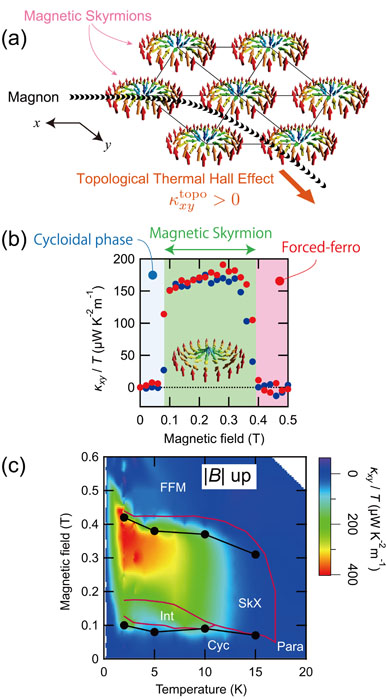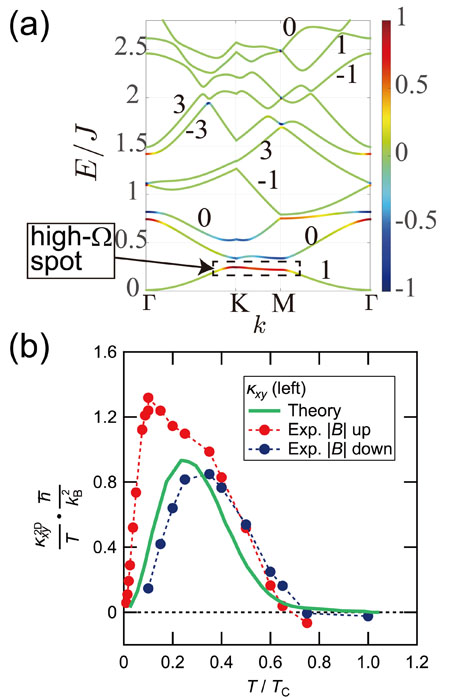Topological Thermal Hall Effect of Magnons in Magnetic Skyrmion Lattice
Yamashita Group
Currently, research on the effects of emergent magnetic fields created by spin structures in solids is attracting much attention. This is because such emergent magnetic fields directly affect the wave function of electrons, giving rise to more drastic effects on electrons than those caused by an external magnetic field. One of the most celebrated examples is the emergent magnetic field produced by a magnetic skyrmion – a vortex texture of spins in a magnetic solid (see Fig. 1(a)). For conduction electrons in a metal, it is well known that the topological Hall effect is given by the emergent magnetic field of the magnetic skyrmions of which the field strength is equivalent to several hundred tesla in external magnetic field. On the other hand, it has been unknown how the emergent field acts on charge-neutral heat carriers in insulators, such as magnons and phonons.

Fig. 1. (a) A schematic illustration of the topological thermal Hall effect of magnons in the lattice of magnetic skyrmions. The flow of the magnons is bent by the emergent magnetic field produced by the vortex spin texture of the magnetic skyrmions. (b) The magnetic field dependence of the thermal Hall conductivity (κxy). A finite κxy sharply appears in the magnetic skyrmion phase (green shared area), but disappears in the cycloidal (blue) and the forced-ferromagnetic (pink) phases. (c) A color plot of κxy /T observed in the magnetization process (“|B| up”).
In this study [1], we investigated in detail the thermal transport properties in GaV4Se8, a ferromagnetic insulator in which a magnetic cycloidal phase at zero-field below the Curie temperature is transformed into a magnetic skyrmion phase by applying a magnetic field (Fig. 1(c)). We find that, whereas the thermal Hall effect is absent both in the cycloidal and the forced-ferromagnetic phases, a clear thermal Hall effect appears in the magnetic skyrmion phase (Fig. 1(b)). A color plot of the thermal Hall conductivity (κxy) demonstrates the position of the magnetic skyrmion phase in the B–T phase diagram as shown in Fig. 1(c). In addition, the thermal Hall signal is increased by increasing the domain volume of the magnetic skyrmion phase by cooling the sample under a magnetic field through the structural phase transition. These results indicate that the observed thermal Hall signal is caused by the emergent magnetic field of the magnetic skyrmion lattice.
We confirm that this is indeed the case by theoretically calculating the heat transport of the magnons in the magnetic skyrmion lattice. We find that the calculated magnon bands, which are folded by the lattice of the magnetic skyrmions, acquire non-trivial Chern number. In particular, as shown by the Fig. 2(a), the magnon bands around the top of the lowest magnon band have a large Berry curvature (“high-Ω spot” in Fig. 2(a)), giving rise to the topological thermal Hall effect of the magnons. Based on this magnon band calculation, we estimate the temperature dependence of κxy, and find that our calculation well reproduces the experimental result observed in the demagnetization process (see the green solid line and the blue data in Fig. 2(b)). On the other hand, κxy observed in the magnetization process shows a very different temperature dependence that persists at lower temperature than κxy in the demagnetization process (red data in Fig. 2(b)). This unexpected hysteresis might indicate that the lattice of the magnetic skyrmion is more disordered in the magnetization process, suggesting a difference in the skyrmion lattice depending on whether it is formed from the forced-ferromagnetic phase or the cycloidal phase. Although this possibility should be scrutinized by future measurements of the skyrmion lattice, this hysteresis in κxy shows a high sensitivity of the thermal Hall measurements for the skyrmion lattice structure not attainable by other measurements.

Fig. 2. (a) Energy bands of the magnons in the lattice of magnetic skyrmions along high-symmetry points. Color denotes the Berry curvature that is normalized in each band. (b) Temperature dependence of κxy/T by calculation (solid line) and experiments (symbols). Experimental data obtained at 0.36 T in the magnetizing (|B| up) and 0.2 T in the demagnetizing (|B| down) processes are shown in red and blue circles, respectively. To fit with the theoretical result, the horizontal axis of the experimental data is normalized by the Curie temperature TC = 20 K. See [1] for more details.
References
- [1] M. Akazawa, H.-Y. Lee, H. Takeda, Y. Fujima, Y. Tokunaga, T. Arima, J. H. Han, and M. Yamashita, Phys. Rev. Research 4, 043085 (2022).
